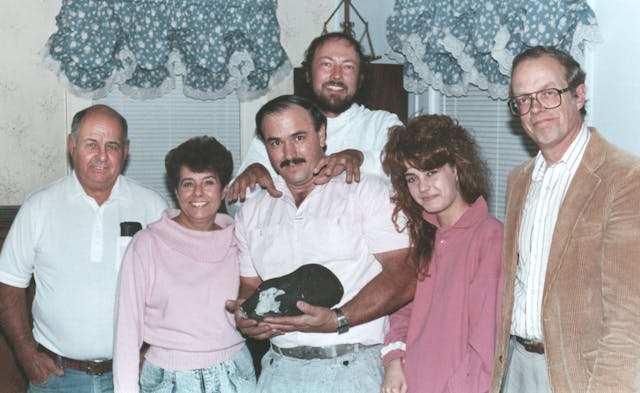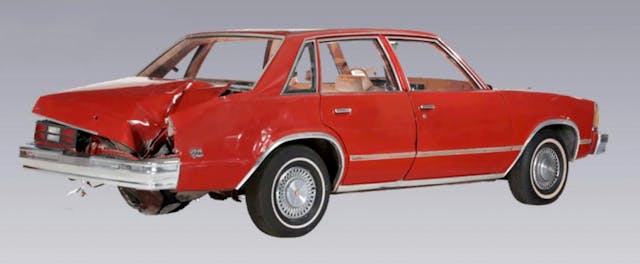When a meteorite mashed a Chevrolet in New York
When Chevrolet’s marketing team described the 1980 Malibu as “a fresh new slice of apple pie,” it was reaching. The really earth-shattering Malibu news came later—and it had nothing to do with apple pie, minor styling alterations, or additional horsepower.
On October 9, 1992, at 7:50 p.m. EDT, 18-year-old Michelle Knapp was watching television in her parents’ home in Peekskill, New York, when she heard a loud, metallic crash. She thought it was a car accident. Scrambling outside, Knapp discovered a hole in the trunk of her red-orange 1980 Malibu sedan. Beneath the hole, embedded in the gravel driveway, was a bowling ball–sized rock that was warm to the touch and smelled like sulfur. Shaped like a football, it was only about a foot in diameter, but it was heavy for its size—about 27 pounds.
Knapp called the Peekskill Police Department, thinking she was the victim of vandals, but a neighbor suggested that no human could throw a rock through a car, especially not one that size. The following day, a curator from the American Museum of Natural History in New York City confirmed what her neighbor and family already suspected: This was no ordinary rock.

Scientists later determined that a meteorite had hurtled to Earth from the inner edge of our solar system’s main asteroid belt, between Jupiter and Mars, traveling through space at a cosmic velocity of 8.8 miles per second (or about 31,600 miles per hour). Slowed by the earth’s atmosphere, the meteorite had began to break up over Kentucky. A shard struck Knapp’s Malibu at 164 mph, barely missing the car’s fuel tank.

Witnesses in Ohio, Pennsylvania, New York, Virginia, North Carolina, and D.C. described seeing a “huge greenish fireball” streak through the night sky towards Peekskill. Because the meteorite had crashed to earth on a Friday night, while many high-school football fans were taping games on their camcorders—remember, this was long before iPhones—16 different video cameras captured the space rock’s descent (as documented on metoritecar.com).
The video below, which does not have sound, was taken in Johnstown, Pennsylvania, about 335 miles west of Peekskill:
This video was shot in Halifax, Pennsylvania, about 200 miles west of Peekskill:
The amazing story of the meteorite that slammed into a Malibu was reported in newspapers and on television around the world. Knapp, her car, and the rare space rock became instant celebrities.
The teenager, who a year earlier had purchased the Malibu from her grandmother for $400, quickly sold the car to Iris Lang, wife of meteorite collector and dealer Al Lang, for $25,000. (Twenty years later, in 2012, the car’s original title and a rear taillight bulb, which was broken by the meteorite, sold at auction for $5312.)
In addition to selling the car, Knapp received $50,000 for the meteorite from three investors—Jim Schwade, Marlin Cilz, and Ray Meyer—who subsequently cut it into pieces and sold the specimens to museums and collectors for many times that original figure. In 2012, for example, an 83.68-gram (2.95-ounce) piece was auctioned for $16,250, which is about $5500 per ounce. For comparison, gold has a value of $1669 per ounce as of this writing.

While the meteorite’s monetary value is extraordinary, the rock itself is about as mundane as Knapp’s Malibu was prior to October 9, 1992. As far space rocks go, anyway. Technically, the meteorite is an H6 chondrite, which the Lunar and Planetary Institute defines as “an ordinary chondrite from the H group that is petrologic type 6.”
As for the car, it now belongs to Darryl Pitt, founder and curator of the Macovich Collection of Meteorites, which also owns an 890-gram (nearly two-pound) section of the rock itself. In the years since the meteorite and the Malibu met in Peekskill, the car has been on display in numerous museums throughout the world, including New York City’s American Museum of Natural History and France’s National Museum of Natural History.

“Apart from the earth itself,” Pitt told USA Today in 2017, “the Peekskill meteorite car remains the most famous object to be struck by a meteorite.”
Considering that on November 30, 1954, Ann Hodges was hit by a meteorite as she napped on her couch in Sylacauga, Alabama (and lived to tell the tale), Pitt’s opinion may be a little over the top, but he certainly isn’t alone. Chevy marketers also overstated the Malibu’s appeal, and that was 12 years before one was serendipitously hit by a space rock.
Check out the Hagerty Media homepage so you don’t miss a single story, or better yet, bookmark us.



My grandmother had this exact same model and it was one of the worst cars ever built. The meteor did everyone a favor.
Actually the meteorite hitting the car was probably the best thing that could have happened to it. It was obvious from the photos from when it was first hit that it was well weathered. Now you can see its well taken care of and preserved. If it had not happened it would have been recycled completely by now.
When I was a teen in Mass back in the 50’s, I found a meteor in a field, it was huge and you could see were the molten steel in it was melting while burning through the atmosfeer. At that time I was a member of the museum star watchers and I brought in a chunk that was varified real. Back in those days it was no big deal. I went back 30 years later looking for it and because of new development, it was gone. That rock was at least 3 feet in diameter and I would have been a million air today if I new about the future worth and a way to move it. It would not fit on my bicycle.
I own a Meteor but I’m never going to get that kind of money for it.
Thanks for the reminder of the Big Hair era also.
I simply love that picture of Ms Knapp and the meteorite/buyers. It is SO 80s. Love it, love it, love it!